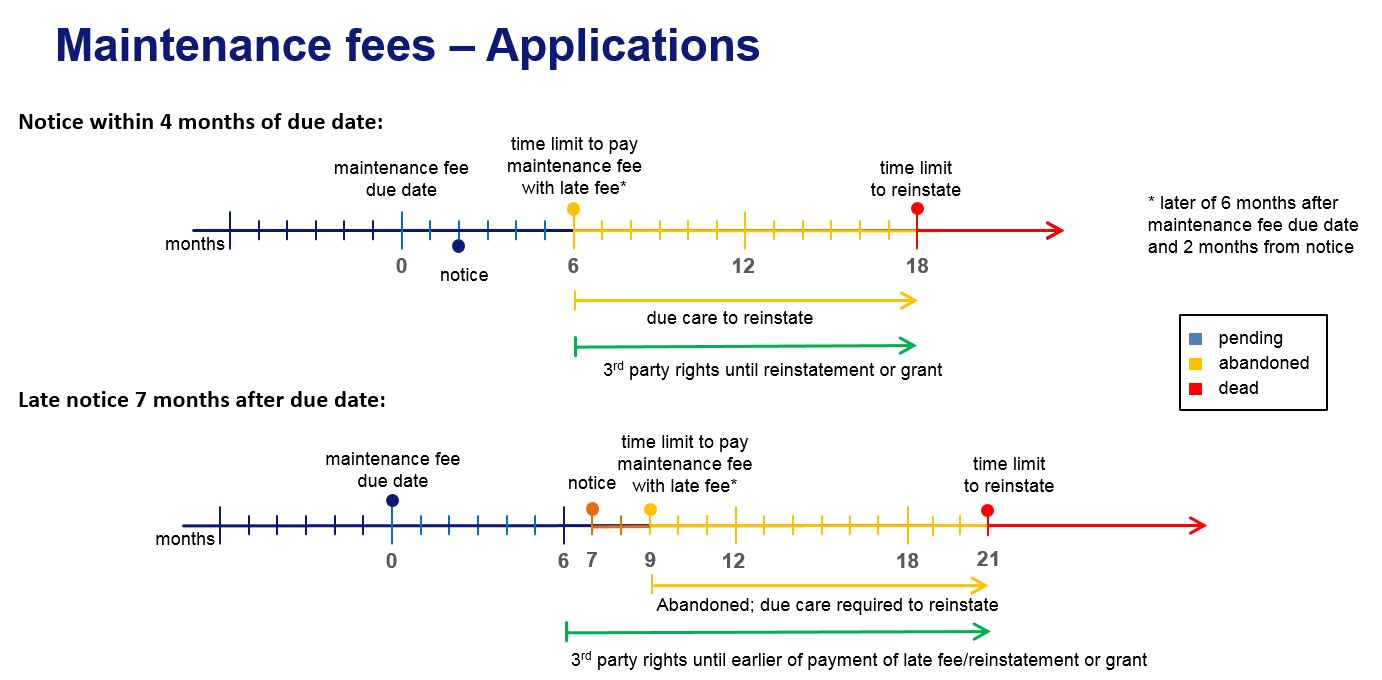In 2014, Canada's patent law was amended to comply with Canada's obligation under the Patent Law Treaty (PLT), but implementation required amending the Patent Rules. The Patent Rules have now been finalized, and amendments to both the Patent Act and Rules will come into force on October 30, 2019 (CIF).
As mentioned in the first article, this series of articles1 will cover the most significant amendments that affect users of the system, and in the transition to the new regime, will discuss options available to Applicants.
Maintenance Fees
The basic scheme for paying maintenance fees on Canadian patent applications and patents remains unchanged in many respects. Maintenance fees will still be due annually from the second anniversary, and the fee amounts remain unchanged.
There are some significant changes in Canada's amended Patent Act and Rules, notably: providing a Notice to Applicants when a maintenance fee is not paid on time; changes to reinstatement provisions when application or patent goes abandoned for non payment of the fees; separate fees for late payment and reinstatement; and providing that the Applicant or anyone authorized by the Applicant can pay a maintenance fee and late fee (but not a reinstatement fee). Additionally, while not required by the PLT, third party rights, when fees are paid later than six months from a prescribed date (see below), are introduced.
As the requirement for maintenance fee is prescribed in the Patent Act, an Applicant or Patentee will not otherwise receive the Notice to pay the fee from the Canadian Intellectual Property Office (CIPO). However, if the annual maintenance fee is not paid by the prescribed date, that is, on or before the anniversary of the filing date, the Commissioner must send a Notice. The Notice will state that the application will be deemed abandoned if the maintenance fee and a late fee are not paid by the later of the end of 6 months after the prescribed date and 2 months after the date of the Notice.
The following charts shows timelines for paying the maintenance fee on an application, with the first timeline showing a timely issued Notice, so that the due date for the maintenance fee and the late fee is 6 months after the prescribed date. The second timeline shows a later issued Notice, such that the due date for the maintenance fee and the late payment is calculated as 2 months from the Notice date, since the Notice has arrived so that its 2 month period is after the expiry of the 6 months after the prescribed period.

As indicated, if the maintenance and late fees are not paid, then the application is deemed to be abandoned.
An abandoned application may be reinstated within 12 months of date of deemed abandonment, if the Applicant pays the maintenance and late fees, and also a reinstatement fee. The Applicant must also state the reasons for the failure to pay the maintenance fee.
The application will only be reinstated if the Commissioner determines that the failure occurred in spite of the due care required under the circumstances having been taken.
Due care is a new provision in Canadian patent law, and it is not yet clear what standards will apply. As the general intent of the revisions is to harmonize Canada's laws, CIPO has advised that the applied standard will be consistent with Receiving Office guidelines under the Patent Cooperation Treaty, namely:
assess whether patentee (and it is understood this includes all parties involved in paying a fee, e.g. the agent of record) took all measures that a reasonably prudent person would have taken, given the circumstances, to avoid the failure.
A request for reinstatement should include details of:
the circumstances that led to the failure;
the measures that the person took to avoid the failure (including any remedial or alternative steps that were taken to avoid the failure); and
any other justifications and evidence.
CIPO has indicated that an Applicant will be informed of the Office's intended determination and given an opportunity to make observations.
For granted patents, generally the same timelines and considerations apply, and third party rights may similarly arise.
As indicated, third party rights to use the invention start at 6 months past the due date, irrespective of whether or not the application is abandoned or not. Third party rights provide that, if, a person, in good faith, committed an act that would otherwise constitute an infringement, or made serious and effective preparations to commit the infringing act, that act is not an infringement. This is a new provision and is unclear exactly how extensively it will be interpreted by the Courts. However, these third party rights may subsist for the life of the patent. Similarly, third party rights can arise if the examination fee for an application and a late fee are not paid within 6 months of the original due date to pay the examination fee.
Footnotes
1. A Practical Guide to the transition to Canada's new Patent Act and Rules Part I
The content of this article is intended to provide a general guide to the subject matter. Specialist advice should be sought about your specific circumstances.
